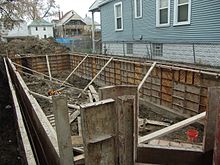Cast-in-place concrete
This article needs additional citations for verification. (February 2019) |

Cast-in-place concrete is a technology of construction of buildings where walls and slabs of the buildings are cast at the site in the formwork.[1] This differs from precast concrete technology where slabs are cast elsewhere and then brought to the construction site and assembled.[2] It uses concrete slabs for walls instead of bricks or wooden panels, and formwork is used for both walls and roof.
Advantages of this technology are strength of the building, insulation, versatility for different types of buildings, faster construction time. Disadvantages are requirement of labour is more etc.[3]
References
- ^ "Removable Forms (Cast-In Place)". Cement.org.
- ^ "Precast Concrete vs. Site Cast Concrete - What Are They?". Nitterhouseconcrete.com. 8 September 2017.
- ^ "Archived copy". Archived from the original on 2019-02-18. Retrieved 2019-02-18.
{{cite web}}: CS1 maint: archived copy as title (link)
